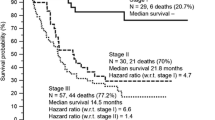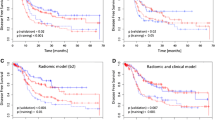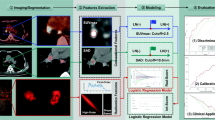Abstract
Purpose
The present pilot study investigates the putative role of radiomics from [18F]FDG PET/CT scans to predict PD-L1 expression status in non-small cell lung cancer (NSCLC) patients.
Methods
In a retrospective cohort of 265 patients with biopsy-proven NSCLC, 86 with available PD-L1 immunohistochemical (IHC) assessment and [18F]FDG PET/CT scans have been selected to find putative metabolic markers that predict PD-L1 status (< 1%, 1–49%, and ≥ 50% as per tumor proportion score, clone 22C3). Metabolic parameters have been extracted from three different PET/CT scanners (Discovery 600, Discovery IQ, and Discovery MI) and radiomics features were computed with IBSI compliant algorithms on the original image and on images filtered with LLL and HHH coif1 wavelet, obtaining 527 features per tumor. Univariate and multivariate analysis have been performed to compare PD-L1 expression status and selected radiomic features.
Results
Of the 86 analyzed cases, 46 (53%) were negative for PD-L1 IHC, 13 (15%) showed low PD-L1 expression (1–49%), and 27 (31%) were strong expressors (≥ 50%). Maximum standardized uptake value (SUVmax) demonstrated a significant ability to discriminate strong expressor cases at univariate analysis (p = 0.032), but failed to discriminate PD-L1 positive patients (PD-L1 ≥ 1%). Three radiomics features appeared the ablest to discriminate strong expressors: (1) a feature representing the average high frequency lesion content in a spherical VOI (p = 0.009); (2) a feature assessing the correlation between adjacent voxels on the high frequency lesion content (p = 0.004); (3) a feature that emphasizes the presence of small zones with similar grey levels inside the lesion (p = 0.003). The tri-variate linear discriminant model combining the three features achieved a sensitivity of 81% and a specificity of 82% in the test. The ability of radiomics to predict PD-L1 positive patients was instead scarce.
Conclusions
Our data indicate a possible role of the [18F]FDG PET radiomics in predicting strong PD-L1 expression; these preliminary data need to be confirmed on larger or single-scanner series.




Similar content being viewed by others
Data availability
The datasets generated during and/or analyzed during the current study are available from the corresponding author on reasonable request.
References
Rizvi NA, Hellmann MD, Snyder A, Kvistborg P, Makarov V, Havel JJ, et al. Cancer immunology. Mutational landscape determines sensitivity to PD-1 blockade in non-small cell lung cancer. Science. 2015;348:124–8.
Hersom M, Jørgensen JT. Companion and complementary diagnostics-focus on PD-L1 expression assays for PD-1/PD-L1 checkpoint inhibitors in non-small cell lung Cancer. Ther Drug Monit. 2018;40:9–16.
Ilie M, Long-Mira E, Bence C, Butori C, Lassalle S, Bouhlel L, et al. Comparative study of the PD-L1 status between surgically resected specimens and matched biopsies of NSCLC patients reveal major discordances: a potential issue for anti-PD-L1 therapeutic strategies. Ann Oncol. 2016;27:147–53.
McLaughlin J, Han G, Schalper KA, Carvajal-Hausdorf D, Pelekanou V, Rehman J, et al. Quantitative assessment of the heterogeneity of PD-L1 Expression in non-small-cell lung cancer. JAMA Oncol. 2016;2:46–54.
Bubendorf L, Lantuejoul S, de Langen AJ, Thunnissen E. Nonsmall cell lung carcinoma: diagnostic difficulties in small biopsies and cytological specimens: Number 2 in the Series “Pathology for the clinician” Edited by Peter Dorfmüller and Alberto Cavazza. Eur Respir Rev [Internet]. 2017;26. Available from: https://doi.org/10.1183/16000617.0007-2017
Takada K, Toyokawa G, Okamoto T, Baba S, Kozuma Y, Matsubara T, et al. Metabolic characteristics of programmed cell death-ligand 1-expressing lung cancer on F-fluorodeoxyglucose positron emission tomography/computed tomography. Cancer Med. 2017;6:2552–61.
Takada K, Toyokawa G, Tagawa T, Kohashi K, Akamine T, Takamori S, et al. Association between PD-L1 expression and metabolic activity on F-FDG PET/CT in patients with small-sized lung cancer. Anticancer Res. 2017;37:7073–82.
Hu B, Chen W, Zhang Y, Shi H, Cheng D, Xiu Y. F-FDG maximum standard uptake value predicts PD-L1 expression on tumor cells or tumor-infiltrating immune cells in non-small cell lung cancer. Ann Nucl Med. 2020;34:322–8.
Zhao L, Liu J, Wang H, Shi J. Association between F-FDG metabolic activity and programmed death ligand-1 (PD-L1) expression using 22C3 immunohistochemistry assays in non-small cell lung cancer (NSCLC) resection specimens. Br J Radiol. 2021;94:20200397.
Amin MB, Edge S, Greene F, Byrd DR, Brookland RK, Washington MK, Gershenwald JE, Compton CC, Hess KR, et al. (Eds.). AJCC cancer staging manual (8th edition). Springer International Publishing: American Joint Commission on Cancer; 2017 [cited 2016 Dec 28]
Vigliar E, Malapelle U, Bono F, Fusco N, Cortinovis D, Valtorta E, et al. The Reproducibility of the immunohistochemical PD-L1 testing in non-small-cell lung cancer: a multicentric Italian experience. Biomed Res Int. 2019;2019:6832909.
Zwanenburg A, Vallières M, Abdalah MA, Aerts HJWL, Andrearczyk V, Apte A, et al. The image biomarker standardization initiative: standardized quantitative radiomics for high-throughput image-based phenotyping. Radiology. 2020;295:328–38.
Fortin J-P, Parker D, Tunç B, Watanabe T, Elliott MA, Ruparel K, et al. Harmonization of multi-site diffusion tensor imaging data. Neuroimage. 2017;161:149–70.
Jiang M, Sun D, Guo Y, Guo Y, Xiao J, Wang L, et al. Assessing PD-L1 expression level by radiomic features from PET/CT in nonsmall cell lung cancer patients: an initial result. Acad Radiol. 2020;27:171–9.
Polverari G, Ceci F, Bertaglia V, Reale ML, Rampado O, Gallio E, et al. F-FDG Pet parameters and radiomics features analysis in advanced Nsclc treated with immunotherapy as predictors of therapy response and survival. Cancers [Internet]. 2020;12. Available from: https://doi.org/10.3390/cancers12051163
Dolled-Filhart M, Roach C, Toland G, Stanforth D, Jansson M, Lubiniecki GM, et al. Development of a companion diagnostic for pembrolizumab in non-small cell lung cancer using immunohistochemistry for programmed death ligand-1. Arch Pathol Lab Med. 2016;140:1243–9.
Author information
Authors and Affiliations
Contributions
LM ideated the study and wrote the draft of the manuscript; LM, CC, FE, GM, MM, LG, and CL retrospectively evaluated PET/CT scan detecting the volumes of interest (VOIs) for the radiomic analysis; VL, FB, and FP retrospectively collected and evaluated the lung cancer specimens for histological and immunohistochemical characterization; EDB performed the radiomic and statistical analysis; DC provided the clinical data of the cohort; LG, CM, and EAT supervised the whole project and the work and contributed to the final version of the manuscript; all the authors critically reviewed and approved the final version of the present paper.
Corresponding author
Ethics declarations
Ethics approval
This study was performed in line with the principles of the Declaration of Helsinki. Approval was granted by the Ethics Committee of ASST Monza—Unimib (3865).
Competing interests
The authors declare no competing interests.
Additional information
Publisher's note
Springer Nature remains neutral with regard to jurisdictional claims in published maps and institutional affiliations.
Lavinia Monaco and Elisabetta De Bernardia are Co-first authors
This article is part of the Topical Collection on Advanced Image Analyses (Radiomics and Artificial Intelligence)
Supplementary Information
Below is the link to the electronic supplementary material.
Rights and permissions
About this article
Cite this article
Monaco, L., De Bernardi, E., Bono, F. et al. The “digital biopsy” in non-small cell lung cancer (NSCLC): a pilot study to predict the PD-L1 status from radiomics features of [18F]FDG PET/CT. Eur J Nucl Med Mol Imaging 49, 3401–3411 (2022). https://doi.org/10.1007/s00259-022-05783-z
Received:
Accepted:
Published:
Issue Date:
DOI: https://doi.org/10.1007/s00259-022-05783-z




